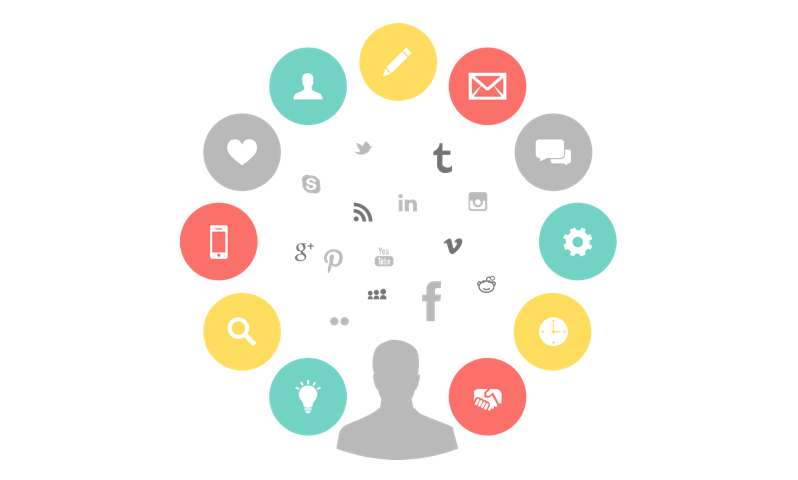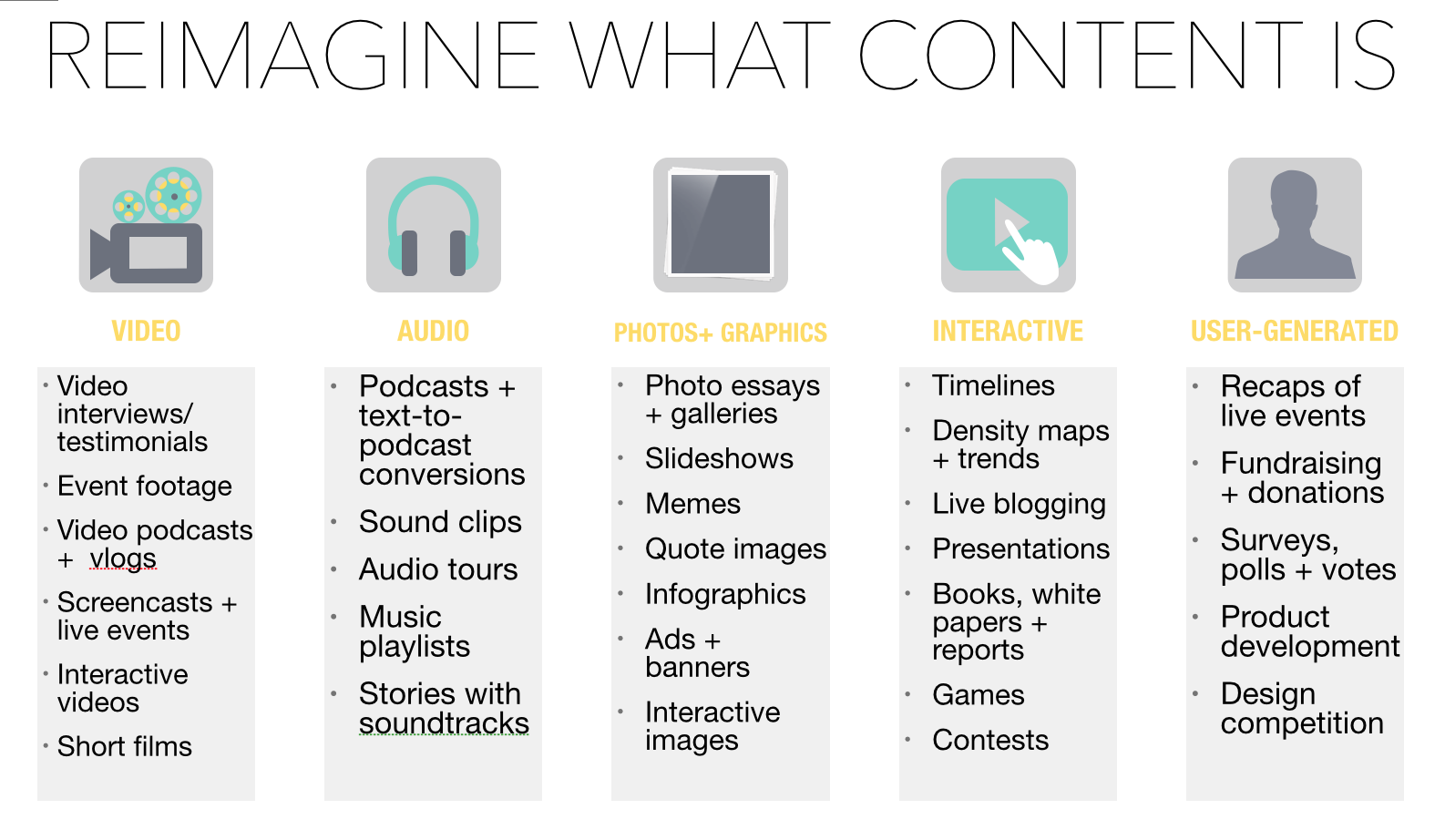
As content marketing remains the cornerstone of today’s leading brand strategies, marketers grapple with how to effectively tell their brand stories in creative, resonating ways that not only reach, but engage their audiences. The adage “Content is king,” while still relevant and true, loses its power in the face of the question: “How can content truly be used effectively?”
It’s all fine and good that content rules the digital landscape, and even better if there’s an ample supply, but what good does all of that content do if it’s not being used, and used well?
One of the biggest hurdles brands face in the content marketing race is content creation. Many of my past and current clients have struggled to create content—what’s more, they often don’t even know where to begin. Even after creating a solid content creation plan—with a brand vision, key content pillars, message map and supporting topics—brands often stop when they reach the content execution phase. Choices around tools, content formats, interactivity and experience, especially with so many options available today, can be overwhelming, and brands are hurting themselves with inaction.
How Content Creators Can Compete Tomorrow
How can content creators set themselves apart and be heard over all of the noise? Even better, how can they disseminate compelling and resonating content that engages their target audience? It’s all about creative storytelling that leverages all forms of technology and digital media.
When content creators think about “setting themselves apart” from tomorrow’s content creator pool, it’s all about anticipating how to tell the right story, at the right time, to the right people, using the right tools. Sound simple? With practice and good storytelling skills, content creators can convey any message in the right way.
In order to do this, content creators need to blend a little marketing know-how, research and analysis, and intuition to: (1) Choose the right story format and reimagine what content is, (2) leverage innovative content creation tools, (3) plan for accessibility, connectivity and mobility, (4) account for audience values and interests, and (5) design for the overall experience.
Here’s how content creators can, and should, approach content creation.
1. Choose the Right Story Format and Reimagine What Content Is
After developing the message, the most important part of content is the form in which it takes. All too often content starts, and ends, with text. Text-only content is extremely effective. Consider the amount of content conveyed with text via email, social posts, instant messaging, articles, news and information digested every day.
However, more and more studies prove the human brain processes visual and audible content differently and more effectively, making content in visual and audio form not only more ideal, but the best choice in telling certain stories. Consider the following:
- Visual content can be processed 60k times faster by the human brain (than non-visual content).
- A recent study conducted by all-in-one content amplification platform Shareaholic found YouTube to be the best platform for engaging users, demonstrating video’s engagement power.
- Kids who are taught math with an experimental music curriculum scored 40% higher on the final fractions test than those who didn’t, connecting musical beats with comprehension.
- According to eMarketer, photos accounted for 75% of content posted by Facebook pages worldwide, indicative of human nature’s inclination to share and capture memories through photo.
- In 2014, the amount of video from people and brands in Facebook’s News feed increased 3.6X year-over-year. As the platform changes to support the video format, more users are capturing content accordingly.
- Tweets with images have higher engagement: Buffer found these posts get 18% more clicks, 89% more favorites and 150% more retweets.
- A study conducted by Edison Research found that 1.7% of the total time Americans spend listening to audio was spent listening to podcasts.
Brand marketers need to reimagine what content is, and plan for content that takes the form of video, audio, photos/graphics, interactive content and even user-generated opportunities. And depending on the overall message, the nature of the content and how the audience inevitably engages with that content will determine the format. Here are some ideas:

Video. Choosing a video clip over a short paragraph may deliver compelling ideas far more effectively. Specifically, live streaming, interactive videos and short films are taking video to new levels depending on the type of content (event coverage versus case example), audience engagement method (quick and digestible versus long-form research) and overall objective (product sale versus customer retention).
Audio. Lately, video is often the first thing marketers think of when thinking about multimedia content. However, podcasts continue to engage audiences, and this medium’s popularity proves that audio shouldn’t be discounted. Brands with access to audio content should leverage it with audible messaging.
Photos + Graphics. Brands with interesting photos can show, not tell, their story—even demonstrate how a product works through how-to galleries. Factor in the need to have a photo with every article in order to support social media sharing, consistent photographic branding can set a brand apart.
Interactive. Big data offers options for depicting content in unique ways, especially for historical dates, density data, trending information and live events. This kind of content dictates a different format for audiences to digest the information. Timelines, live blogging and even games become engaging approaches.
User-generated. Brands with broad communities also can leverage them by creating unique content on their own. Think Lay’s “Do Us a Flavor” contest or McDonalds “Build Your Own Burger” crowdsourcing campaign.
Thinking outside the text-based box leverages all of the storytelling formats that resonate with audiences.
2. Leverage Innovative Content Creation Tools
Today, there’s a new tool for every type of content, data set or story format that can help marketers truly engage the target audience. These digital creations tools are changing the way we tell stories, and they’re allowing content creators with minimal technology and budgets to create multidimensional stories quickly and easily.
Case in point: Look at Interlude Video, where brands are telling their stories through interactive “choose your own adventure” video narratives. MAC makeup has a Date Night vs. Girls’ Night video that walks the user through getting ready for a night out. The product “sell” is subtle and playful with choices focused on experience and choice played out like a short movie, rather than a typical ad spot or placement.
Taking your brand from a broadcast-only messaging strategy to an interactive, audience engaging approach strengthens brand identity and customer loyalty.
Content creators should use tools to assist in this storytelling challenge. A short list of creative tools that make it easier for content creators include:
Mindie. This iOS app transforms stories into “everyday music videos.” Features include slow motion, time lapse, filters and captions to add color and information to video clips.
Dipity. The free tool helps creators develop interactive, embeddable timelines ideal for historical documentation that integrates video, audio, images, social media, location and more into one visualization.
Visual.ly and Piktochart. Both options help non-designers create visual content with little graphic design know-how. With built-in templates and reasonable cost, a brand can create a shareable infographic and other visuals with ease.
Exposure. As a photo narrative community tool, Exposure takes simple photo galleries and transforms them into an integrated photo-driven post. For photographers, this takes photos to a whole new level. Photo narratives also are embeddable, allowing for content sharing.
Snapguide. The free iOS app creates step-by-step how-to guides using pictures, videos and captions.
Haiku Deck. Positioned as a “new kind of presentation software,” the iPad- and web-based software provides tips and templates to package content in a unique way.
3. Plan for Accessibility, Connectivity and Mobility
All too often, marketers don’t anticipate the time and place audiences will engage with content the content. This takes some research, audience analysis and understanding of how targets not only engage with brand content but even how they navigate their daily lives. Lifestyle habits can impact content engagement greatly.
- For sales professionals, a majority of their time is spent on the phone talking to prospects or in meetings with clients. Typically on the go, mobility is important, as well as quickly digestible content. They have little time to invest, and often use commuting time to engage with content. Timing content availability during that time will maximize exposure.
- Millennials increasingly desire content in bite-size chunks, and have little patience to wait for slow load times. Typically mobile, this audience will engage with content on their timetable, making it important for brands to be “on” 24/7.
- The tech community wants to experience content in different ways, specifically that leverages the latest technology. Finding truly unique, integrated ways to tell stories may break brands away from the pack.
- Niche communities, however, may be willing to engage with content longer, because coverage of the topic may be limited. Brands in these spaces can take advantage for longer form content (long videos, white papers, photo essays) because the audience is willing to invest the time.
Knowing how your audience operates in daily life, and the types of devices, internet connectivity and habits, will prep you for higher engagement opportunity by meeting them where and when they are.
4. Account for Audience Values and Interests
As audience targeting increasingly becomes more and more segmented, successful marketers will separate targets based on values and interests. Already Millennial marketing is turning away from viewing the 16-year generation (which includes 18-year-old high school graduates, 24-year-old entry-level professionals and 34-year-old home buyers) as one all-inclusive group and moved toward a segmentation model.
In 2014, Boston Consulting Group released a groundbreaking report that started to unfold the complexity of this target group and how to uniquely reach them. This research defined the Millennial market by six value sets, allowing for better targeting and content creation that truly resonates with each group.
Of course, audience segmentation is complex and takes analysis, but it’s important for brands to understand what their audiences care about most. Additionally, with more and more content being disseminated, the true engagement determinant will be whether it resonates. To do that, values and interests become more and more important for content creators to consider.
5. Design for the Overall Experience
Experiential design takes into account not only the anticipated experience the audience will have with a particular piece of content, but where in the “experience” timeline will the audience first engage the content. Is the audience first interacting with the content via an email campaign or did they see a social promotion post? Are they already a loyal customer visiting a website or are they searching for a particular answer to a problem? Is a prospect discovering a brand for the first time through an advertisement?
Each entry into the content engagement timeline will shift how the content is experienced by the audience—and no two targets experience content the same. Brands need to anticipate this and plan for it by making the entire experience seamless, consistent and easy to navigate. That means making branding consistent, visuals the same and a true experience no matter how the audience first approaches it. This takes plans and forethought, but when done right, makes a considerable impact. Content creators should keep this in mind when creating content, as opportunities for supporting elements may come to mind.
Setting Yourself Apart
Today’s content creators have an opportunity to take stories to a whole new level. With digital advancements, they also have access to the tools that will enable them to do this. However, the content creation process isn’t as simple as it once was, and far more complex than taking a pen to paper to document an idea. Understanding the way content is interacted with and how a specific audience prefers to engage will make a brand story that much more powerful. Content creators, and brands, willing to invest in the content creation process will set themselves apart.

Be inspired.
Kate has an incredible amount of drive when it comes to LoganSquarist. In the six months that I’ve been involved, I’ve watched the site grow from a pet project to a respected community publication. This success can be attributed to Kate’s technical and leadership skills. From building out the site to off-hours community management and a consistent flow of content, the site improves by leaps and bounds on a weekly basis. When it comes to team management, Kate delegates tasks in an organized and efficient manner, making her an all around great and inspiring person to work with.
I worked with Kate during my time as a community manager at Lightspan Digital while Kate was my direct manager. Kate’s communication practices really taught me how to navigate the sometimes complicated agency world. As an account manger, Kate smoothly orchestrated 10+ accounts at one time as well as help me manage and prioritize tasks in my role. Kate was a role model during my first few years in the professional world and continues to be so to this day.
One of the best things I've ever done in my career is work with Kate Hamilton. Her enthusiasm for all things editorial, not to mention her energy and passion for any project she's involved with, is contagious. In addition to being a natural born leader, she's also a creative type, a thinker, a stickler for details, and someone with incredible vision and the drive to get things done. I always marvel at how she is constantly teaching herself new things. She always seems to be ahead of the curve on anything related to social media, and she also has an eye for design. This lady rocks! And she continues to be a mentor to me and others in journalism and communications.
Kate is a wealth of knowledge who served as a tremendous mentor for all of our team members while constantly improving processes and workflows. She’s a tremendous project manager, pays great attention to detail, and is able to demand results from her team with respect. At LoganSquarist she has built and led a team of dozens of volunteer contributors committed to her vision of a community resource. I would happily work with Kate again anytime!
I met Kate through the Association of Women Journalists (AWJ) and immediately was impressed (and inspired) by her creativity, drive, work ethic and use of social media. Her passion for journalism, digital media and communications overall is evident in the projects she takes on, including LoganSquarist, an online news outlet that she founded that uses social media to socialize the neighborhood. What I admire about Kate is her vitality as well as her desire to keep learning and growing personally and professionally. Kate is a modern-day renaissance woman who is multitalented (ask about her travel, knitting and marathon exploits!) and who brings instant value to any team or organization.
Kate did and excellent job with our website. We have received several compliments on how nice it looks and how easy it is to navigate. She also went above and beyond to make sure that we were able to update and the website ourselves through Wordpress. I cannot gush about how awesome she is and how happy we are with the site and her dedication to the project.
Kate is a real professional and a pleasure to work with. She is a great communicator and always put her client's (my company) interest first. She is tremendously personal and had a great understanding of our business and how she could help it. She is great and is a tremendous asset to any company.
Kate has been a fantastic resource for all things digital, whether redesigning my website on Wordpress, fine tuning my social media profiles, or understanding Google Analytics. She's an excellent communicator, and I will absolutely hire her again in the future.